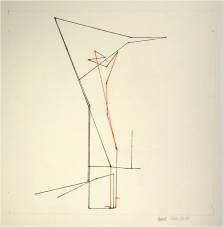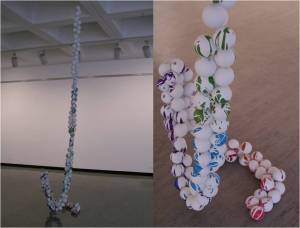T H E F R O N T I E R
a charlotte street 15 year anniversary project considering the history and future of artist-driven pioneering in Kansas City and the changing nature of the city's "frontiers"
Alexandra Robinson
Interview with Alexandra Robinson
Jonah Criswell: When was your UCP Residency?
Alex Robinson: My residency started during the spring of 2006. I was originally in the Bank building and moved over to the Bonfils space. I shared an open studio space with Milton Stevenson IV.
JC: How do you feel that the UCP Residency helped you further your work?
AR:I had been back in Kansas City for a few years and was showing at various small spaces in the region but I had yet to commit to a studio space. I had studios in the past prior to grad school but hadn’t had one since getting my first teaching job. Submitting my materials and receiving the space was the continued support my artistic practice needed. (I always feel that studio residencies, exhibitions and studio visits help validate the practice for each artist. Not that we need permission but it is nice to get support for your work.) I think the residency aloud for me to work larger, to work on more ambitious projects, for me, at the time. I was definitely able to think through that year and realize that I needed and wanted to have a studio space. It helped me take my work more seriously, to push myself to meet people in the art community in Kansas City and question my place in it and question the work I was making.
JC:In your statement you talk about real or perceived environments as sources of inspiration for your installations, is there a particular recurrent feature to those environments?
AR: The biggest influence my work has had was spending a summer in the high desert of west Texas. I was an intern at the Chinati Foundation during the summer of 2003. I had access to the work and the community of interns and artist in residence as well as the community in Marfa but the biggest impact was the landscape.
As a kid I visited Texas a lot because my mothers family is from there. I remember laying in the back seat and looking up into the vast sky with the puffy white cumulonimbus clouds. I remember the road laid out in front of you, the surrounding golden landscape and the telephone poles going on and on into the distance. My experience in Marfa was similar because I could see forever and the sky was huge.
The shift was realizing that the vegetation in the land was extremely fragile. Because of how dry and with often drought conditions if you were to drive and walk on the land you could kill it, likewise, it would instantly grow and bloom after a rain. This compounded by the apartment I lived in while at Chinati which was white on white on white transformed my need for experiencing a painting (so to speak) into a realization that these small spaces of fragility were embedded in our daily experiences. For example, light traveling across a wall during the course of a day. Who has time to watch and experience this? Do you even notice it? At Chinati I had time to do this and document it. I wanted to imbue these ephemeral; fragile often unnoticed life elements into site-specific installations.
It is this type of practice and experience that I have been in search of since and that finds its way into every installation.
JC: You mentioned the fragility of the landscape in west Texas, is there a sense of the fragile in your work?
AR: I think I perceive the fragility in my work with the ephemeral quality of it. The installations often can be deconstructed in a matter of minutes and if they were reinstalled somewhere else they would look completely different. In the past too, I have created work that was destroyed through the de-installation; this is interesting to me. However, as process would have it, I have recently started making work out of materials (plastic and plastic bags) that do not biodegrade. The permanence of the materials juxtaposed against conceptual ideas that revolve around the very notion of ephemerality really interests me.
JC: Also, there is a sense of the celebratory in responding to an environment; do you see your work as celebratory?
AR: Yes, I think there is a sense of the celebratory. I am constantly shocked. Friends, places and experiences surprise me continually. I am constantly saying things like, “I don’t remember that at all.” I wonder sometimes if I walk around like a bull in a china shop just going about my way never noticing anything. I think this notion totally informs my work in that I wonder so much about this that I make it such a focus, like, I didn’t notice that…now I want you (the viewer) to see it too.
JC:I completely agree with the statement that residencies, studio visits, and exhibitions help validate your studio practice! How long into your UCP residency were you when you started to “expand” or become more ambitious in your scope?
AR: While at Bonfils I shared a space with Milton Stevenson. He has gone on to graduate with an MFA from RISD and is now in New York. I started my residency half way through his and he was in the midst of his application to grad school while we shared the studio. I remember thinking that I need to make this residency turn into something else. I worked on things such as securing a studio at the now defunct Arts Incubator and applied for a solo show at the Underground Gallery at the Artist Coalition. But, I also expanded my scope by applying for and receiving an Inspiration Grant through ArtsKC Fund. These types of achievements just gave me an added confidence to continually push for more opportunities.





Pingback: Frontier: Momentum and Trajectory « T H E F R O N T I E R